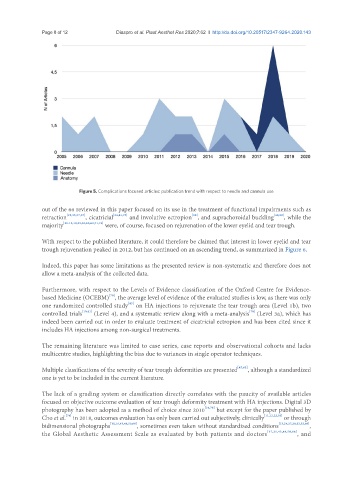Page 732 - Read Online
P. 732
Page 8 of 12 Diaspro et al. Plast Aesthet Res 2020;7:62 I http://dx.doi.org/10.20517/2347-9264.2020.143
Figure 5. Complications focused articles: publication trend with respect to needle and cannula use
out of the 66 reviewed in this paper focused on its use in the treatment of functional impairments such as
[18]
retraction [23,35,37,67] , cicatricial [34,41,75] and involutive ectropion , and suprachoroidal buckling [40,59] , while the
majority [11-13,19,22,30,62,69,71,74] were, of course, focused on rejuvenation of the lower eyelid and tear trough.
With respect to the published literature, it could therefore be claimed that interest in lower eyelid and tear
trough rejuvenation peaked in 2012, but has continued on an ascending trend, as summarized in Figure 6.
Indeed, this paper has some limitations as the presented review is non-systematic and therefore does not
allow a meta-analysis of the collected data.
Furthermore, with respect to the Levels of Evidence classification of the Oxford Centre for Evidence-
[78]
based Medicine (OCEBM) , the average level of evidence of the evaluated studies is low, as there was only
[43]
one randomized controlled study on HA injections to rejuvenate the tear trough area (Level 1b), two
controlled trials [16,41] (Level 4), and a systematic review along with a meta-analysis (Level 3a), which has
[76]
indeed been carried out in order to evaluate treatment of cicatricial ectropion and has been cited since it
includes HA injections among non-surgical treatments.
The remaining literature was limited to case series, case reports and observational cohorts and lacks
multicentre studies, highlighting the bias due to variances in single operator techniques.
Multiple classifications of the severity of tear trough deformities are presented [45,62] , although a standardized
one is yet to be included in the current literature.
The lack of a grading system or classification directly correlates with the paucity of available articles
focused on objective outcome evaluation of tear trough deformity treatment with HA injections. Digital 3D
photography has been adopted as a method of choice since 2010 [14,76] but except for the paper published by
[74]
Cho et al. in 2018, outcomes evaluation has only been carried out subjectively, clinically [11,12,22,33] or through
bidimensional photographs [15,16,43,48,50,68] , sometimes even taken without standardized conditions [13,24,27,28,32,52,69] ,
the Global Aesthetic Assessment Scale as evaluated by both patients and doctors [17,21,43,48,50,66] , and

